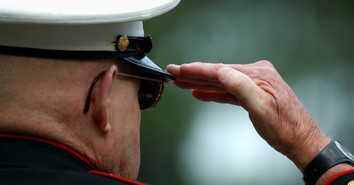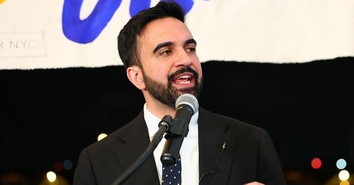We Want to Be Pursued!

Men, did you know you hold in your power the key to solving every single woman’s No. 1 frustration?
You don’t have to be among Christian single women very long to hear one common refrain: “We want to be pursued”—followed close on the heels by “Why won’t the guys ask us out?” As I sifted through the survey data for my book, Where Have All the Good Men Gone?, and started tallying responses by women, this one topic took up so much space, literally, that it demanded a leading position in the book.
Today many would argue that women enjoy the right, even the freedom, to pursue men if they choose without ruffling any societal feathers. A woman can be the first one to call a guy she’s just met. She can flirt with him via email. She can even ask him out on a date. And all the secular women’s magazines will applaud her for her gutsy behavior. Yet almost every woman surveyed for this book expressed feelings that are polar-opposite to this bold stance: They want to be pursued, or “wooed and won” as an earlier generation called it.
I once read a magazine article with the opener: “How did a generation of women grow up wanting to marry Edward Rochester?” The protagonist of Charlotte Bronte’s classic Jane Eyre is dark, brooding, intelligent, quick-witted yet cynical. Still, for all his negative qualities (Jane herself describes him as “not handsome”) Rochester manages to captivate not only Jane but thousands of female readers who have read the novel during the nearly two centuries since Bronte penned it. The same could be said for Jane Austen’s elusive Mr. Darcy. Brooding, arrogant, disagreeable… Yet one key attribute sets both men apart—and, I suspect, keeps the women who read about them yearning to encounter just such a man in real life: Deep inside, both Darcy and Rochester are deeply passionate souls, and in the course of their respective stories, they step up to the plate and let their romantic feelings for the girl be known. They arrive at a point in time where the ardor of their affections forces them to “declare themselves” to the girl or woman of their choosing. In short, they pursue.
There’s something very attractive about being pursued with intent. In fact, most women in my survey cited this as a feature that might entice them to date someone. One woman, aged 30-34, wrote in her survey response, “Before my present boyfriend, I had a series of 'confusing friendships' in which I spent a lot of time with certain guys and there seemed to be mutual interest (there was on my part and I thought I recognized enough 'signals' from his end to hope it was) that ended up going nowhere. During these friendships, these guys and I would call each other, flirt, talk on the phone, seek each other out in social settings, spend one on one time together, and even be seen talking excessively at parties or other group gatherings to the point where people commented on it and thought we might be 'hanging out.'”
She continues: “I think a big part of what attracted me to my current boyfriend is that he actually had the guts to ask me on a date, to make his interest known and to pursue me. After over five years in a church young adult group, he's one of the only ones who have actually asked me out. … I think guys need to buck up and ask girls out and not just rely on maybe seeing a girl at some church group event or whatever. ...”
Pursuit—ah, that’s it really, when it all boils down to the essence. As I scanned the responses from real women in my survey, I heard a repeated longing to be pursued, to be wooed, to be won, in the old-fashioned sense of the word. My own mother’s generation had another phrase for this courtship dance: “I chased him till he caught me.” Is there a hint of coy flirtation in that phrase? You bet. Is there perhaps an implicit understanding that women have an active role to play in the chasing-and-catching dance? Absolutely. But at its core this archaic statement speaks of what I simply call the longing.
What is it that feeds this longing within women? The source is as ancient as the dawn of time, and the setting is the Garden of Eden. Listen to God’s own words in Genesis:
To the woman [God] said:
“I will greatly multiply your sorrow and your conception;
In pain you shall bring forth children;
Your desire shall be for your husband…”
For me, this spells out—and makes sense of—the deep emotional need within woman that longs for the love of a man, particularly the love of one special man. In essence, woman is afflicted with this desire. Indeed, most women prefer the love of one good man over the attentions of many men.
The world may have moved on, become hip and high-tech and politically correct, but the old-fashioned values persist in our very makeup. We can’t get away from who we are as women—created with a longing that goes deep. Some men may enjoy the season of “sowing their wild oats” and jockeying from one woman to the next, but it’s rare to find a woman who actually prefers multiple men to one good one. So it’s all the more frustrating when we see men we like, send signals that we’re interested (eye contact, lively conversation, hair-flipping, flirting, etc.), and they do nothing. The frustration can even send well-meaning and sincerely searching Christian women to other wading pools beyond the one marked “Christian” only.
All this talk about longing to be pursued begs the question: What does pursuit look like in the modern-day world, the real world we inhabit, not the one Jane Austen lived in?
The Dating Dance
What does pursuit look like in a world where formal pronouncements and calling cards have given way to text messages and MySpace referrals? Though many women long for the old-fashioned protocols, most don’t honestly expect a man to show up on her doorstep in a cold-call appeal for love, bouquet in hand. In fact, it might be a little creepy. From talking to other women, I got the feeling that pursuit of any kind is preferable to a man sending “interested” signals and then never acting on them (excluding stalker tactics).
“It seems like somehow Christian men are either painfully awkward in the approach or painfully awkward in not approaching,” writes one woman. “They are either way too forward in their approach (definite turnoff) or they hover forever, hoping maybe we'll take the lead. Non-Christian men just don't seem to have the inhibition most Christian men I've experienced seem to have, which is sad. I would just like Christian men to treat me like an attractive person they would like to get to know better, as opposed to either the elixir for their insecurities (‘Please just say yes’) or a long-term commitment if they ask me to coffee.” Perhaps the more awkward men could take cues from the following examples.
A young woman I know went to dinner with friends one night, and before leaving their waitress brought over a slip of paper. As she handed the paper to my friend, she said, “See that waiter over there? He’s cute, right? Well, he wanted me to give this to you.” She smiled and left the table. My friend unfolded the slip of paper and saw that it contained the guy’s name and phone number. She couldn’t stop talking about it all night. I asked her if she planned to call the guy, and she said yes. Flattering? Yes. Creepy? No. The way this guy handled it was tactful and classy, showing genuine interest but putting the right of refusal (or reciprocation) into the girl’s hands.
One time a man in a video store made eye contact with me. We both kept glancing at each other to the point where he approached me and casually asked if I had seen a particular movie, and could I recommend it. It was a nice gesture and had a natural feel to it. We bantered for a few minutes and might have exchanged emails (a far safer first-communication medium than phone numbers, in my opinion) but my youngest daughter walked up right then, and the situation quickly turned awkward. I mumbled something like “nice to meet you” and left the store knowing I would probably never see him again. Again, the approach was flattering but not creepy—and later I could have kicked myself for leaving the store without exchanging some medium of future contact. One love-and-dating expert who writes columns for Yahoo recommends that single men and women keep a modern-day “calling card” for just such a purpose.
Just Friends—or More?
Enough women in my survey mentioned guy friends they were interested in that it makes one Jane Austen scenario of particular interest for modern couples: the classic scene in Emma (the movie) between the title character and her friend/neighbor, Mr. Knightley, when he finally declares his love. Prior to this scene, Emma has awakened to her feelings for Mr. Knightley, clued in by her own fierce jealousy upon learning that her friend Harriet Smith has designs on him. About the same time, Knightley, who has always been attentive and there for Emma, decides to step up his game and make his intentions known to her—he wants to be more than a friend to her. The next time they meet, the scene is charged with raw emotion—a new, awkward awareness of love on Emma’s part, and an eager attitude of entreaty of the part of Knightley. He begins to declare his love for her when she stops him, thinking he is about to divulge his love for Harriet instead.
In typical comedy-of-errors fashion, they almost don’t connect during this poignant love scene, but the audience knows these two are meant for each other. Finally Emma tells Mr. Knightley she was rude to cut him off, and anything he wishes to tell her, she will listen to with respect. Knightley says some unforgettable words: “Emma, you always want to keep me as your friend, but I hope someday to call you something much dearer than a friend.” At that moment Emma realizes for the first time that her love for Mr. Knightley—her best friend—is actually reciprocated, and she may at last call him “my Mr. Knightley.”
There’s a sweetness to the scene that’s hard to surpass in literature or film. But the truly thrilling moment comes when Knightley finally breaks the barrier between friendship and romance by declaring his love for Emma. And, men, that’s exactly what we women are longing for you to do with us, to let us know you’re wanting to take the relationship to the next level. Granted, the situation can be tricky when it comes to letting a guy or girl friend know you’re interested in much more than palling around for the rest of your life. Yet who wants to risk losing a potential mate just to save face? At some point we all have to decide a certain risk is worth the taking—as the commercial says, “Life comes at you fast.”
Ironically, single Christian men echoed the same “friend” complaint that many women offered, but with a twist—while women complained that the men friends they want to be with won’t “step up” (read: take the relationship beyond friendship to dating), men complained that many women only want to be friends when they show romantic interest in them. Much of this may be a classic case of unrequited love, but I wonder how many couples never get together simply because one person never finds the courage to tell the other that, like Knightley, he/she hopes someday to call the other much more than a friend.
Tips for Shy Guys
I’m tempted to think the bolder men reading this don’t need any cues for how to pursue a woman they like, but my single friend David tells me almost every guy has insecurities when it comes to women. So here goes. I informally polled a handful of single women friends asking them how a man might let them know he’s interested. Their list included the following:
- If you’re in her network of online friends, establish rapport through email or IM first, and then ask her to meet you for coffee (social networking sites like Facebook and MySpace make connecting easier, and you can “hide” behind the written word until you get a yes … or no).
- If you have a mutual friend, let him/her know you’re interested in an introduction with said person that includes the three of you. Believe me, you’ll find out fast if she’s interested too.
- If you know her phone number, send her a friendly—but ever so slightly flirty—text message.
- Ask the waiter serving her table to send over her favorite dessert (or drink) with your name and phone number and/or email address.
- If you work together, find ways to have casual conversations (near the water cooler, in the break room, working on projects together) until you break the ice. Then ask via email if she’d like to go to lunch sometime, your treat.
Of course, there’s no guarantee of success with any of these strategies, and they all still carry the risk of rejection, but trying and perhaps failing is better than never trying and surely failing. And the good news is you just might be pleasantly surprised.
What Does Her Body Language Say?
I said earlier that pursuit is very attractive to a woman, and this can definitely be true. Sometimes a guy who ordinarily wouldn’t turn our head suddenly gets taken seriously when he shows that he’s head over heels for us. However, there’s also a time when over-pursuit is a turnoff, and the simplest way to tell which “light” you’re receiving—green light or red light—is to read our nonverbal cues. Sure, no problem! I can hear you saying. Women are already confusing enough, and now you want us to read their minds? No, their bodies actually. Body language is a surefire way to know what someone is thinking or feeling toward you, and once you grasp a few basic guidelines, you’ll be better equipped to take their interest-temperature: slightly chilly or a warming trend, freezing cold or smoking hot.
Nonverbal Cues That Say ‘Yes, I’m Interested’
- She gazes in your eyes with deep interest and her pupils are dilated.
- She raises both eyebrows exaggeratedly for a couple of seconds, combined with a smile and eye contact.
- She winks at you while talking to you or winks at you from a distance.
- While talking to you, she blinks more than usual, fluttering her eyelashes.
- Her smile reaches her eyes and looks natural and relaxed
- She tilts her head
- She plays with her hair while talking or listening to you (twirling a strand of hair, throwing her hair back off her shoulders, etc.)
- She fixes, pats, or smoothes her outfit while talking to you
- If her legs are crossed (while sitting), the upper leg is crossed toward you
- She is turned toward you, whether sitting or standing
- She plays with her jewelry
- She touches your arm, shoulder, or hand while talking to you
- She raises or lowers the volume of her voice to match yours
- She speeds up or slows down her speaking to match yours
- She laughs in unison with you
- In a crowd she speaks only to you and focuses her undivided attention on you
- She mirrors your body language and body positions
Signs That Say ‘No’
- She never glances your way (across a room, in a crowd)
- She makes only fleeting eye contact
- She looks away quickly, eyes level
- Her posture is unchanged
- She does not preen or play with her hair in any way
- She turns her body away
- Her head remains vertical, her eyes neutral
- She maintains a neutral, polite face
- Her eyes appear normal or dull, no light
- She keeps her mouth closed
The words of one single woman who responded to my survey sums it up better than I ever could. “Men, please don’t be afraid to ask us out on a date. One date doesn’t mean it is a serious relationship. And ‘hanging out’ shouldn’t last very long. If you like us, ask us out. Be brave—we like that more than you know.”


You can reach her at www.ajkiesling.com or by e-mailing her at goodmengone@gmail.com.
**This article first published on May 15, 2008.
Originally published May 12, 2009.







